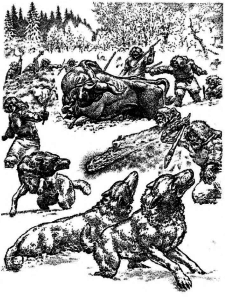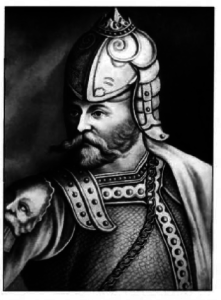Lithuania’s vast forest tracts were some of the last havens for two species of spectacular wildlife, the European bison and the aurochs, or stumbras and tauras respectively in Lithuanian. Archeologists have found images of these animals in cave paintings, clay figures, and carvings from the Stone Age. Similarly, the stumbras and tauras are imprinted on the history and culture of Lithuania. Even the language shows their traces. Being large bovine animals, equally symbolic of wildness and strength, the bison and the aurochs are often confused and misidentified. Part 1 of this two-part series in the Movember/December 1999 issue of Lithuanian Heritage dealt with the stumbras, its history in Lithuania, and its rescue from extinction. In the following article, Part 2 of the series, we consider the tauras, a legendary beast whose descendents are domestic cattle of today.
Part 2 Tauras
ACCORDING TO A LITHUANIAN LEGEND, KING Gediminas was out hunting in the vicinity of the stream called the Vilnia where it flows into the Neris river. There he slew an [unusually large wild bull identified as being a member of a now extinct species known to science as Bosprimigenius and to Lithuanians as “tauras.” This species of wild ox is called the aurochs in English. Since the animal in the tale is described as large, its height at the withers would have been at the upper end of the range for an aurochs, which is 1.6 meters. That’s approaching six feet. The animal’s weight might have been around 800 kilograms (nearly 1800 pounds), the upper end of the weight range estimated for the aurochs bull.
It was late in the day,so Gediminas decided to camp out rather than return home in the dark to his castle at Trakai. That night he is said to have dreamt about an iron wolf whose howl was like the howls of a hundred wolves combined. The story goes on to relate how chįef seer, Lizdeika, interpreted the dream to mean that it was that place that Gediminas will found a capital city which will become renown worldwide. Of course, the city is Vilnius where there is even a hill bearing the name “Tauro Kalnas” or aurochs’ hill. This hill is located between Pam ėnkalnio and Tumo-Vaižganto streets on which is situated the Profsąjungų Rūmai (the Soviet-era Palace of Unions.) The horns of Gediminas’ wild bull were probably fashioned into drinking vessels and kept as trophies in accordance with an ancient custom.
Writing about Lithuanian hospitality and the types of drinking vessels that Lithuanians used, historian Teodoras Narbutas (1838) states: “Those vessels made of horn were placed on stands, usually of precious metal, and were decorated with gem stones, fitted with handles, covers, and hanging decorations. Such horns were usually passed from generation to generation, as a significant remembrance of the one who had killed with his own hands the animal whose horns these were. Descendants of the grand ducal family kept horns of an aurochs that Gediminas had killed on Tauro Kalnas at Vilnius. In 1429, while Vytautas was visiting with Emperor Sigismund [of the Holy Roman Empire] in Lutsk, the Lithuanian ruler presented him with a splendid drinking horn.”* We will never know whether the Gediminas legend has any basis in fact, and we can’t even be certain that the animal that he slew was indeed a member of the species Bos primigenius as this animal is confused with the bison C Bison bonasus ) with great regularity. Since it is definitely known that both bison and aurochs were present during the medieval period, it will have to be assumed that the original tellers of the tale knew the difference. The aurochs is regarded by scientists as the ancestor.


*Lutsk (Luckas in Lithuanian), located in present-day Ukraine, was one of the most important Lithuanian cities during the 14th-16th centuries, and one of the residences of Vytautas the Great. A summit of European heads of state was convened by Vytautas in January of 1429 to discuss and solve eastern and central European problems. The rulers of the Holy Roman Empire, Poland, Muscovy, and the Teutonic Order, and the representatives of the Pope, the King of Denmark, the Byzantine Emperor, the Golden Horde, the Hanseatic League, the Russian cities of Novgorod, Pskov, Riazan, Tver and many other provinces and territories attended. During this conference, the Holy Roman Emperor promised to send Vytautas a royal crown. In order to feed the participating dignitaries and their retinues for fifty days, Vytautas had one hundred aurochs slaughtered each day, in addition to hundreds of elk, steer and lamb.
Although it is extinct as a wild species, it’s genes for the most part still exist in that vast pool of cattle genes including those that give domestic cattle their characteristics such as high milk production, docile disposition, meatier carcass, and coat colors that mark particular breeds. Just as the aurochs has left a rich legacy in the form of all those economically valuable cattle breeds, so has the very name of the animal spawned an interesting cluster of words in the Baltic lexicon. It’s obvious that the Lithuanian word “taurė” or chalice reflects the fact that the animal’s horns were once used as drinking vessels. It is also obvious where the Latvians got their word for trumpet, “tauris.”
But what of the Lithuanian word “taurus,” meaning noble, honest? In the minds of the ancient Balts the name of this animal was an appropriate metaphor to describe a superior individual. The adjective “taurus” possibly evolved from an expression in Lithuanian translating as “he’s a bull of a man.” There’s a parallel in the English language in the word “bully,” an adjective meaning “excellent” or “first rate.” In the popular etymological consciousness the word bully is associated with bull the animal. Numerous names of places and bodies of water derived from “tauras” dot the Lithuanian landscape. There are the towns and villages of Tauragė, Tauragnai, Tauralaukis, Tauraginai, and Taurkalnė. Taurupys, Taurija, Taurožė, Taura, Taurė, Tauragna, and Taurosta are the names of streams. On the shore of Tauragnas lake is the fortress hill called Taurapilis. Linguists can debate till the cows come home as to whether the town of Tauragė got its name from a wild ox’s horn, a land form on a river bend where wild oxen once roam ed, or from the name applied to craftsmen (“tauragiai”) who fashioned drinking vessels, trumpets, and other useful articles from horn. What seems certain is that the town’s name as well as that of Tauragnai and Tauragna consists of two parts: wild ox — “tauras,” and horn — “ragas.”
One of the main reasons for the disappearance of the aurochs was the rapid developm ent of agriculture, especially in the eighth through the thirteenth centuries. The natural habitats of these animals were river valleys, forest clearings and very sparse forests. Human activity pushed them to the densest forests where they ended up with relatively poor feeding areas. When in contact with free ranging cattle, the aurochs might have become infected with cattle diseases and parasites. They may have been a nuisance to farmers whose fields they invaded or whose cows with which they may have attempted to mate. Also, the aurochs may have been caught for domestication. Hunting was the last straw. Ironically, it was in hunting preserves owned by the nobility that the aurochs had a chance of survival.
One such preserve, the Jaktorow Forest in Poland, was the place where the very last wild aurochs, a cow, died of old age in 1627. There seems to be no clear idea as to when the last tauras expired on the territory of Lithuania. It was most probably in the early 1500s, which is quite late in history, as this species died out long before in most parts of Europe and Asia. A colorfully illustrated antique map of the Baltic area dated 1539 shows part of Lithuania in its southeastern corner. It depicts Sigismund The Old (1506-1548), King of Poland and Grand Duke of Lithuania, seated on his throne. A fire, an oak grove, and a serpent are shown and captioned as objects of veneration by the ancient pagans. In addition, there is an armed man being thrown from his horse by an “urus,” Latin for aurochs. Clearly in the mind of the m p’s creator, Lithuania was an exotic country still inhabited by infidels and ferocious wild beasts. But the traveler and diplomat Sigismund von Herberstein, who was keenly interested in both the aurochs and the bison as big game animals, failed to see or hear of any aurochs during his travels through Lithuania in the years 1517 and 1526. Moreover, the aurochs is not mentioned in the First Lithuanian Statute (1529). Imagine the following scenario:
Scientists assemble genetic material of an extinct animal species and generate living individuals of that species. Then they introduce the animals into a suitable environment where they flourish. Does this sound like Jurassic Park, the science fiction book and film by Michael Crichton in which dinosaurs were recreated from bits of DNA found preserved in amber? Yes, but we are speaking here about the real world, not fantasies out of the mind of a paperback writer.
 DRAUGAS NEWS Lithuanian World Wide News in English
DRAUGAS NEWS Lithuanian World Wide News in English